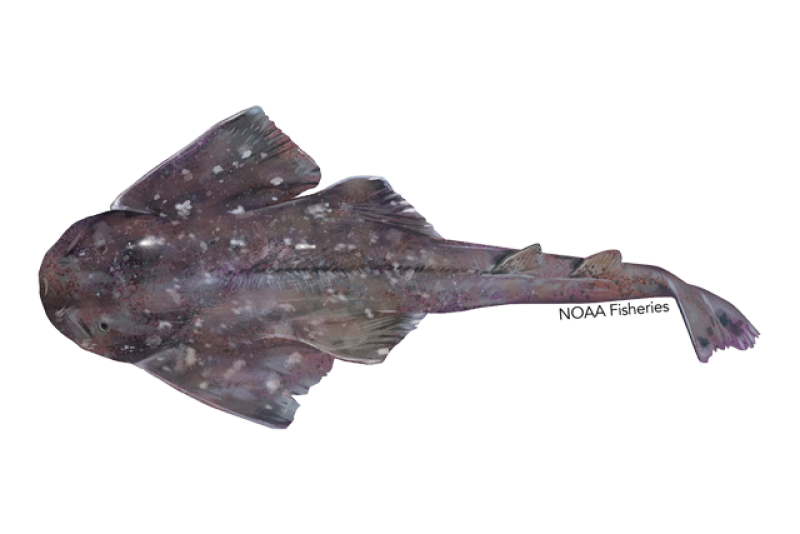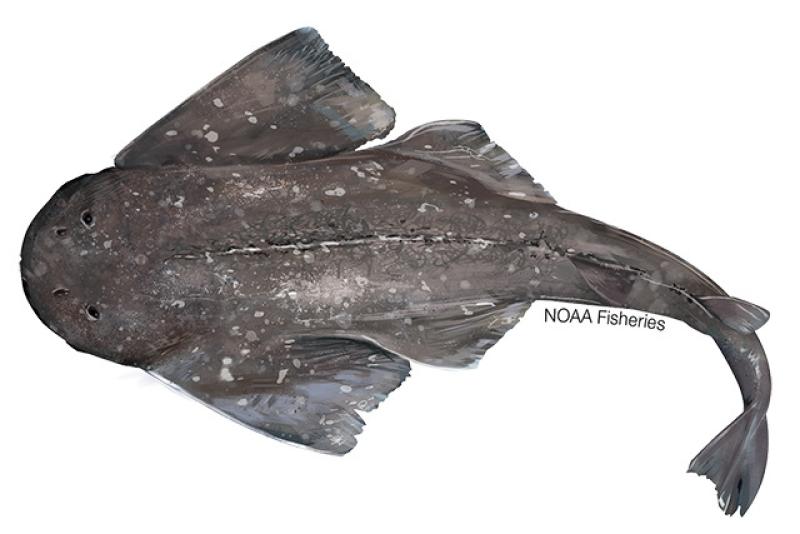Common Angelshark
Squatina squatina

Protection Status
Quick Facts
 Common angelshark - Photo: NOAA Fisheries
Common angelshark - Photo: NOAA Fisheries
Common angelshark - Photo: NOAA Fisheries
About the Species
 Common angelshark - Photo: NOAA Fisheries
Common angelshark - Photo: NOAA Fisheries
Common angelshark - Photo: NOAA Fisheries
The common angelshark is a cartilaginous fish similar to a ray or skate. The species once occurred in waters throughout the Mediterranean Sea and along the eastern Atlantic Ocean, from Scandinavia to Mauritania. It no longer occurs in many areas of the Mediterranean and is rare throughout the rest of its range with one exception—the Canary Islands. The main threat to the common angelshark is commercial fishing, particularly by demersal fisheries, like trawl fisheries, that primarily operate in depths where the common angelshark occurs. In 2016, NOAA Fisheries listed the species as endangered under the Endangered Species Act.
Appearance
Angelsharks are recognized by their batoid shape (similar to a ray or skate). The common angelshark can be distinguished from other angelsharks by its simple and conical nasal barbels, high and wide pectoral fins, and small spines that are present on the snout and above the eyes.
Behavior and Diet
Common angelsharks are ambush predators, meaning they lie in wait for prey to pass closely overhead before attacking. They eat mostly bony fish, other demersal animals, such as skates, crustaceans, mollusks, and cephalopods.
Where They Live
Common angelsharks are found in coastal and outer continental shelf sediment habitats in the Mediterranean Sea and eastern Atlantic. They may also be found in estuaries and brackish water. These sharks are nocturnal bottom dwellers occurring in depths of 16 to 492 feet and prefer to spend most of their time buried in the sand or mud during the day.
 World map providing approximate representation of the common angelshark's range.
World map providing approximate representation of the common angelshark's range.
Lifespan & Reproduction
Little is known about the growth and reproduction of common angelsharks. Female common angelsharks give birth to live young, with a two or three-year reproductive cycle. Gestation is thought to last from 8 to 12 months with litter sizes that range from 7 to 25 pups.
Threats
Commercial and Artisanal Fishing
The primary threat to common angelsharks is overutilization in commercial and artisanal fisheries, particularly demersal fisheries (e.g., trawl fisheries). Historically, angelsharks were so common that fishermen developed a special net designed specifically for catching them. However, over the last 50 years, significant population declines in common angelsharks have been observed, with these declines coinciding with the start of trawling activities in the northeast Atlantic and Mediterranean. Because angelsharks are sedentary, bottom-dwelling species, they are highly susceptible to being caught in demersal and trawl fisheries. Consequently, as these fisheries expanded with the use of steam-powered trawlers in the 1890s, common angelsharks began to suffer significant declines in abundance throughout their historical range. The species is now considered to be extirpated from the western English Channel, North Sea, Ligurian and Tyrrhenian Seas, and Black Sea, and potentially the Catalan Sea and portions of the Adriatic Sea, and is considered rare throughout the rest of its range in the northeast Atlantic and Mediterranean. Because the demersal fisheries that historically contributed to the decline in common angelsharks are still active throughout the species’ range and primarily operate in depths where these angelsharks occur, the species remains at risk of overutilization.
Scientific Classification
| Kingdom | Animalia | Phylum | Chordata | Class | Chondrichthyes | Order | Squatiniformes | Family | Squatinidae | Genus | Squatina | Species | squatina |
|---|
Last updated by NOAA Fisheries on 10/30/2023
Featured News

Related Species
In the Spotlight
Last updated by NOAA Fisheries on 10/30/2023
Management Overview
The common angelshark is listed as endangered under the Endangered Species Act.
Regulatory History
In 2013, NOAA Fisheries received a petition to list the common angelshark as threatened or endangered under the Endangered Species Act. In our 90-day finding, we concluded that the petitioned action may be warranted for the species. After completing a Status Review, we proposed to list the species as endangered and requested comments from the public. In 2016, NOAA Fisheries listed the common angelshark as endangered under the Endangered Species Act.
Key Actions and Documents
More Information
Last updated by NOAA Fisheries on 10/30/2023
Science Overview
Last updated by NOAA Fisheries on 10/30/2023
Documents
Status Review Report of 3 Species of Angelsharks: Squatina aculeata, S. oculata, and S. squatina
This report summarizes the best available data and information on three species of angelsharks …
Last updated by NOAA Fisheries on 10/30/2023




